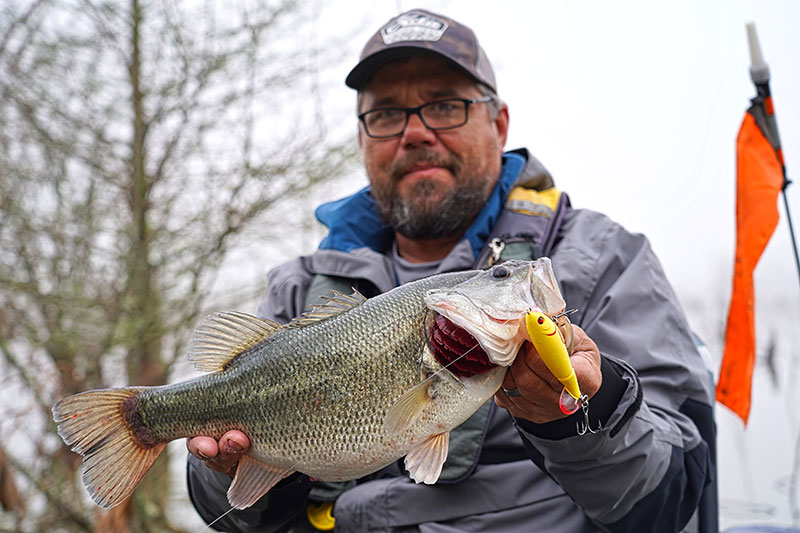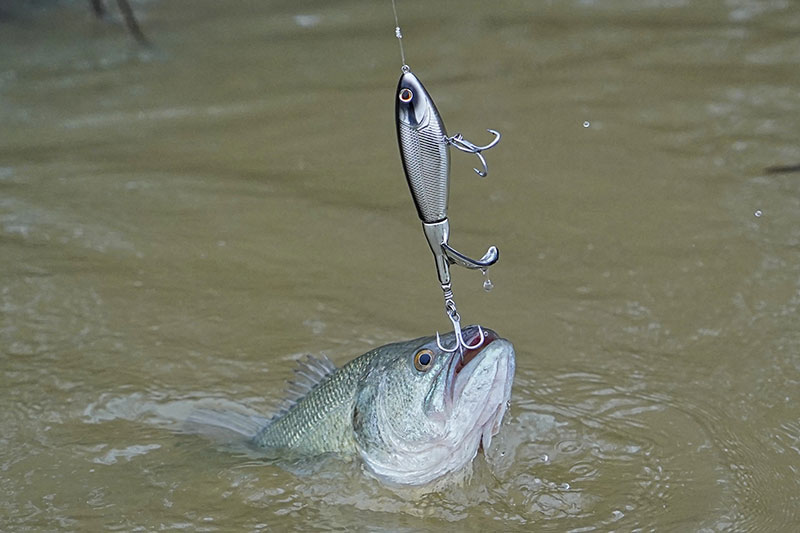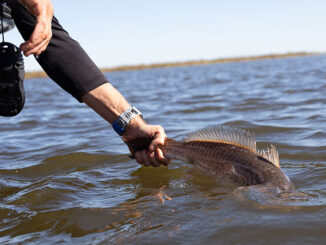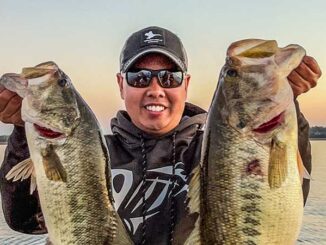
April is still a transition month, but firmly into spring and the weather patterns are getting more consistent. Air and water temperatures continually get higher, as the fish get more active. Whether you kayak fish inshore saltwater or freshwater species, now is the time to break out the topwater lures. Trout, reds, bass, and panfish all can’t resist the tantalizing movements of a topwater lure. The strikes are visual, audible, and exciting.
I’m surprised at the number of kayak anglers that say that they have never, or rarely use topwater lures. If you are one of them, you are missing out on some of the best and most thrilling fishing action there is. Kayaks lend themselves to topwater fishing as their stealthy nature gets you close to the action without spooking the fish. Some like to stand and cast, but with a little patience and practice, productively fishing topwater lures from the seated position in a kayak is not very difficult.
Spinning or casting gear can both be used, but I have found that casting gear provides much more control and accuracy. The goal it to get the lure right where you need it before starting you retrieve actions. Additionally, casting rods generally have shorter handles, which work much better when sitting as they won’t hit your legs or kayak deck while working the lure.
Techniques vary
Topwater lure retrieval techniques vary, but are not difficult to learn. Generally, saltwater anglers prefer a walk-the-dog retrieve where the lure swings side to side as it is slowly worked back towards the kayak. This can be further varied by imparting rod twitches and also some start/stop movements along the way. Even with a lure full of treble hooks, the fish often miss on one or more strikes. This is especially true with redfish as their underslung mouths are designed for bottom rooting rather that top water feeding. However, that doesn’t deter them from providing some great topwater action.
There are two schools of thought when a fish misses a topwater lure. One is to let the lure sit still to see if the fish comes back for a second or third strike. The other is to speed up the retrieve to make the fish think the bait they just missed is attempting to flee, causing a reaction strike. Both methods are effective, but either may not work in a specific situation. If no follow up strikes are had, reel in and cast back over the same general area.
Many freshwater anglers use popping or chugging type topwater lures fishing in calmer areas. Cast the lure to the preferred location — bank point, log or limb or even a defined shadow. Let the lure sit a few seconds until the landing rings dissipate and then start working the lure. Make short pops or twitches, let the lure sit, and then repeat. Explosive strikes generally occur during those moments when the lure is sitting still.

No matter the retrieval technique, setting the hook takes some willpower. Attempting to set the hook immediately upon the strike oftentimes only sends an empty lure flying back towards you. Beware of incoming treble hooks faster than the speed of light. Get in the habit of waiting a second before setting the hook. A good rule of thumb is to wait until you actually feel the weight or pull of the fish on your line. Doing so greatly increases your hookup ratio.
Whether using mono or braided main line, a short length of mono or fluoro leader should be used for a little stretch and extra abrasion resistance. Tying lures on with a simple loop knot also imparts extra fish-enticing movements during the retrieve.
Try a flyrod
Don’t overlook flyrod topwater action, either. For saltwater, larger rods/reels are generally necessary as are larger popping bugs. Walking the dog is a bit difficult with a fly rod, but chugging bug lures utilizing the stop/start technique works well on trout and reds. For bass and bream, smaller fly rods and reels do the trick. From tiny popping bugs that resemble spiders and insects, to larger poppers for bass, flyrods with floating line are easy to cast reasonable distances sitting in a kayak. As always, a little practice makes you more proficient and productive. Try to keep the kayak as free from clutter as possible to avoid tangled fly lines while casting or fighting a fish.
Whether fresh or salt, keep a keen eye out for signs of bait or other water movement. Casting to the edge of bait schools often draws strikes from fish shadowing the school and looking to pick off an easy meal. You want your lure to be easily distinguished from the other hundreds or thousands of baits in the school.
Topwater action in a kayak is super exciting. However, if you find an area with shells or hard bottom, consider staking out the kayak and doing a little wade fishing. The warm water is refreshing and being in the water with the fish you’re catching provides an even more intimate experience than kayak fishing.
Lure color for topwater baits generally appeal more to the fisherman than the fish. The lures float and in all but the clearest of water, only the lower portions of the lure can be seen by the fish. I prefer sticking with more natural patterns with lighter colors on the bottom. Most prey, from baitfish, minnows, crabs to juvenile fish all have lighter bellies and darker backs. This is what the fish are used to seeing. Lures with white or yellow bottoms always work well. Of course, many available other colors and solid patterns all seem to work well also. Find one or two you have confidence in, and they will work well for you.
With only a handful of lures, you can gear up for a day of some of the most exciting kayak fishing there is. Topwater fishing is available year-round, but the spring and summer months offer tons of kayak fishing action.


